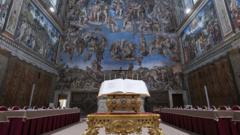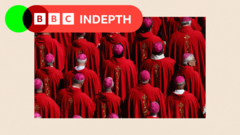With the conclave underway, the fate of the papacy hangs in the balance, potentially marking a significant shift in the Catholic Church's direction.
Conclave Commences: A New Pope in the Making

Conclave Commences: A New Pope in the Making
Cardinals gather in the Vatican as the election for a new pope begins, amid a mixture of anticipation and uncertainty.
The eyes of the world are focused on the Vatican as a solemn procession signals the commencement of the papal conclave. Today, a cadre of cardinals enters the Sistine Chapel to commence voting for the successor to Pope Francis, with many nuances influencing their choices and strategies. Details surrounding the conclave's duration remain elusive; observers note that the anticipated black smoke after initial ballots will indicate inconclusive voting, while eventual white smoke will herald the announcement of the new pope.
As noted by Jason Horowitz, our correspondent from Rome, the conclave’s unpredictable nature is heightened by the current dynamics within the College of Cardinals. The voting process starts with a near symbolic first ballot, serving to gauge the initial support for various candidates. If disagreements persist through consecutive rounds of voting, the lack of consensus could provoke deeper discussions among the electors.
Pivotal to the conclave's proceedings are a few high-profile candidates vying to clinch the papacy. Cardinal Pietro Parolin, the Vatican's Secretary of State, emerges as a likely continuity candidate, maintaining many of Francis's principles and policies. In contrast, Cardinal Luis Antonio Gokim Tagle, a prominent liberal figure hailing from the Philippines, is positioned as a front-runner, potentially making history as the first pope from Southeast Asia.
The underlying theme during this election cycle is a referendum on the legacy of Pope Francis. Cardinals face the critical choice of upholding the current trajectory, reversing certain policies, or seeking a compromise that resonates with diverse factions within the Church. As social media buzzes with speculation, the anticipated decision may redefine the Catholic Church's stance on various contemporary issues, echoing through communities worldwide. In this age-old ritual of selection, the air is thick with reverence and suspense as the next chapter of papal history is poised to unfold.
As noted by Jason Horowitz, our correspondent from Rome, the conclave’s unpredictable nature is heightened by the current dynamics within the College of Cardinals. The voting process starts with a near symbolic first ballot, serving to gauge the initial support for various candidates. If disagreements persist through consecutive rounds of voting, the lack of consensus could provoke deeper discussions among the electors.
Pivotal to the conclave's proceedings are a few high-profile candidates vying to clinch the papacy. Cardinal Pietro Parolin, the Vatican's Secretary of State, emerges as a likely continuity candidate, maintaining many of Francis's principles and policies. In contrast, Cardinal Luis Antonio Gokim Tagle, a prominent liberal figure hailing from the Philippines, is positioned as a front-runner, potentially making history as the first pope from Southeast Asia.
The underlying theme during this election cycle is a referendum on the legacy of Pope Francis. Cardinals face the critical choice of upholding the current trajectory, reversing certain policies, or seeking a compromise that resonates with diverse factions within the Church. As social media buzzes with speculation, the anticipated decision may redefine the Catholic Church's stance on various contemporary issues, echoing through communities worldwide. In this age-old ritual of selection, the air is thick with reverence and suspense as the next chapter of papal history is poised to unfold.





















